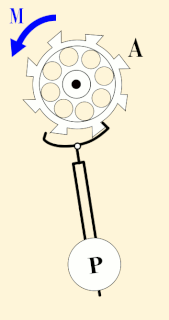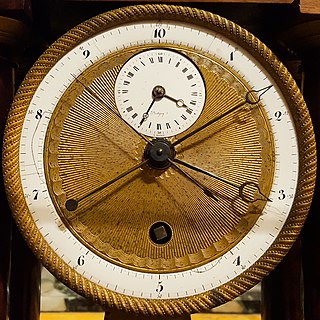
The second is the base unit of time in the International System of Units (SI), commonly understood and historically defined as 1⁄86400 of a day – this factor derived from the division of the day first into 24 hours, then to 60 minutes and finally to 60 seconds each. Analog clocks and watches often have sixty tick marks on their faces, representing seconds, and a "second hand" to mark the passage of time in seconds. Digital clocks and watches often have a two-digit seconds counter. The second is also part of several other units of measurement like meters per second for speed, meters per second per second for acceleration, and cycles per second for frequency.
A nanosecond (ns) is an SI unit of time equal to one billionth of a second, that is, 1⁄1 000 000 000 of a second, or 10−9 seconds.
A millisecond is a thousandth of a second.

A microsecond is an SI unit of time equal to one millionth of a second. Its symbol is μs, sometimes simplified to us when Unicode is not available.
The Julian day is the continuous count of days since the beginning of the Julian period, and is used primarily by astronomers, and in software for easily calculating elapsed days between two events.
Universal Time (UT) is a time standard based on Earth's rotation. There are several versions of Universal Time, which differ by up to a few seconds. The most commonly used are Coordinated Universal Time (UTC) and UT1. All of these versions of UT, except for UTC, are based on Earth's rotation relative to distant celestial objects, but with a scaling factor and other adjustments to make them closer to solar time. UTC is based on International Atomic Time, with leap seconds added to keep it within 0.9 second of UT1.
Metric time is the measure of time intervals using the metric system. The modern SI system defines the second as the base unit of time, and forms multiples and submultiples with metric prefixes such as kiloseconds and milliseconds. Other units of time: minute, hour, and day, are accepted for use with SI, but are not part of it. Metric time is a measure of time intervals, while decimal time is a means of recording time of day.
A femtosecond is the SI unit of time equal to 10-15 or 1⁄1 000 000 000 000 000 of a second; that is, one quadrillionth, or one millionth of one billionth, of a second. For context, a femtosecond is to a second as a second is to about 31.71 million years; a ray of light travels approximately 0.3 μm (micrometers) in 1 femtosecond, a distance comparable to the diameter of a virus.
A picosecond is an SI unit of time equal to 10−12 or 1⁄1 000 000 000 000 of a second. That is one trillionth, or one millionth of one millionth of a second, or 0.000 000 000 001 seconds. A picosecond is to one second as one second is to approximately 31,689 years. Multiple technical approaches achieve imaging within single-digit picoseconds: for example, the streak camera or intensified CCD (ICCD) cameras are able to picture the motion of light.
The light-second is a unit of length useful in astronomy, telecommunications and relativistic physics. It is defined as the distance that light travels in free space in one second, and is equal to exactly 299,792,458 metres (983,571,056 ft).
An order of magnitude of time is usually a decimal prefix or decimal order-of-magnitude quantity together with a base unit of time, like a microsecond or a million years. In some cases, the order of magnitude may be implied, like a "second" or "year". In other cases, the quantity name implies the base unit, like "century". In most cases, the base unit is seconds or years.

The Year 2038 problem is a time formatting bug in computer systems with representing times after 03:14:07 UTC on 19 January 2038.

Phosphorescence is a type of photoluminescence related to fluorescence. When exposed to light (radiation) of a shorter wavelength, a phosphorescent substance will glow, absorbing the light and reemitting it at a longer wavelength. Unlike fluorescence, a phosphorescent material does not immediately reemit the radiation it absorbs. Instead, a phosphorescent material absorbs some of the radiation energy and reemits it for a much longer time after the radiation source is removed.

Femtochemistry is the area of physical chemistry that studies chemical reactions on extremely short timescales in order to study the very act of atoms within molecules (reactants) rearranging themselves to form new molecules (products). In a 1988 issue of the journal Science, Ahmed Hassan Zewail published an article using this term for the first time, stating "Real-time femtochemistry, that is, chemistry on the femtosecond timescale...". Later in 1999, Zewail received the Nobel Prize in Chemistry for his pioneering work in this field showing that it is possible to see how atoms in a molecule move during a chemical reaction with flashes of laser light.
Indian Standard Time (IST), sometimes also called India Standard Time, is the time zone observed throughout India, with a time offset of UTC+05:30. India does not observe daylight saving time or other seasonal adjustments. In military and aviation time IST is designated E* ("Echo-Star"). It is indicated as Asia/Kolkata in the IANA time zone database.

Decimal time is the representation of the time of day using units which are decimally related. This term is often used specifically to refer to the time system used in France for a few years beginning in 1792 during the French Revolution, which divided the day into 10 decimal hours, each decimal hour into 100 decimal minutes and each decimal minute into 100 decimal seconds, as opposed to the more familiar UTC time standard, which divides the day into 24 hours, each hour into 60 minutes and each minute into 60 seconds.

A unit of time is any particular time interval, used as a standard way of measuring or expressing duration. The base unit of time in the International System of Units (SI) and by extension most of the Western world, is the second, defined as about 9 billion oscillations of the caesium atom. The exact modern definition, from the National Institute of Standards and Technology is: "The second, symbol s, is the SI unit of time. It is defined by taking the fixed numerical value of the cesium frequency ΔνCs, the unperturbed ground-state hyperfine transition frequency of the cesium 133 atom, to be 9192631770 when expressed in the unit Hz, which is equal to s−1."

Earth's rotation or Earth's spin is the rotation of planet Earth around its own axis, as well as changes in the orientation of the rotation axis in space. Earth rotates eastward, in prograde motion. As viewed from the north pole star Polaris, Earth turns counterclockwise.
In computing, an epoch is a date and time from which a computer measures system time. Most computer systems determine time as a number representing the seconds removed from particular arbitrary date and time. For instance, Unix and POSIX measure time as the number of seconds that have passed since Thursday 1 January 1970 00:00:00 UT, a point in time known as the Unix epoch. The NT time epoch on Windows NT and later refers to the Windows NT system time in 10−7 s intervals from 00:00:00 1 January 1601.

Coordinated Universal Time or UTC is the primary time standard by which the world regulates clocks and time. It is within about 1 second of mean solar time at 0° longitude such as UT1 and is not adjusted for daylight saving time. It is effectively a successor to Greenwich Mean Time (GMT).








